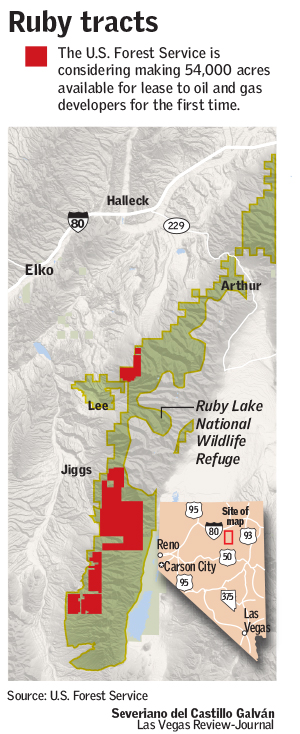Forest Service plan would open Ruby Mountains to oil, gas drilling
The U.S. Forest Service is prepared to open almost 54,000 acres in the Ruby Mountains to new oil and gas exploration, according to a document obtained by an environmental group fighting the plan.
In its draft environmental assessment, the forest service is proposing to allow fossil fuel leases on all of the land requested by and oil and gas developer in the Rubies but with restrictions that would prevent any surface disturbances.
The developers would have place their wells and other equipment on neighboring Bureau of Land Management property and use horizontal drilling or hydraulic fracturing to reach any deposits beneath the requested forest lands in the iconic Nevada mountain range about 370 miles north of Las Vegas.
The Center for Biological Diversity released the draft document Thursday after obtaining it as part of a Freedom of Information Act request.
It’s unclear when the agency plans to unveil the finished version of its assessment or whether changes might be made to the final document.
In a statement Thursday, Bill Dunkelberger, forest supervisor for the service in Nevada, said only that the oil and gas leasing analysis prepared by his office is “under review by the U.S. Department of Agriculture Forest Service Washington Office.” 
Concern over fracking risk
Patrick Donnelly, Nevada state director for the conservation group, said the service’s plan to restrict surface activity on the land does offer some protection, but water resources and wildlife habitat are still at risk.
“They could conceivably frack directly under a creek that’s filled with Lahontan cutthroat trout,” Donnelly said, referring to Nevada’s official — and federally protected — state fish.
Conservationists, American Indian tribes and hunting groups are also concerned about the proximity of the proposed oil and gas development to the wintering ground for the state’s largest herd of mule deer and prime habitat for sage grouse.
The service received thousands of mostly negative comments about the idea, including protests from the Nevada Department of Wildlife and Sen. Catherine Cortez Masto, D-Nev.
But Assemblyman John Ellison, a Republican from Elko, said opponents of the proposal are making it seem like there would be oil derricks built in the heart of Lamoille Canyon when the land in question is actually nowhere near the scenic alpine landscape most people associate with the Ruby Mountains.
“What they’re talking about fracking is miles down the country on the flats,” he said.
Ellison said he supports protecting the natural splendor of Northern Nevada, but he also thinks “the more oil we can get out of our own country, the better.”
Drilling seen as unlikely
It doesn’t matter anyway, he said, because no one is ever going to drill in the area. As far as Ellison is concerned, the price of oil and the cost of extracting it make such a project about as likely as “hitting the MegaBucks four times in a row.”
The land under consideration extends for about 75 miles along the western slope of the Ruby Mountains, from Lamoille Creek in the north to Sherman Creek in the south. The area is part of the Humboldt-Toiyabe, the largest national forest in the lower 48 states, which covers 6.3 million acres in Nevada and eastern California, including the Spring Mountains west of Las Vegas.
Forest service officials in Elko have said the land has never been drilled for oil or gas, but there has been some limited activity in the past about five miles outside the forest boundary.
The BLM requested the evaluation of the forest land a year ago after a prospective developer expressed interest in the area.
Donnelly said he hopes policymakers and advocates for the Rubies will read the draft plan and pressure the agency to change it.
“This is not the final plan, so the Forest Service can still take a different course of action,” he said. “That’s why we released this document.”
Contact Henry Brean at hbrean@reviewjournal.com or 702-383-0350. Follow @RefriedBrean on Twitter.

















